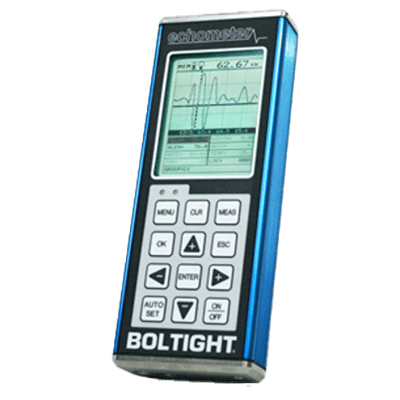What Is Bolt Tension Meter?

Bolt Tension Meter is a measuring instrument to determine the magnitude of the axial force generated by a bolt.
Screws, including bolts, generate a force to fix objects by the elastic force that tries to return the screw itself to its original length after being pulled. The force that the bolt is pulled back to its original length is called the axial force, which is measured by the Bolt Tension Meter. There are two types of Bolt Tension Meter: ultrasonic and hydraulic. The hydraulic type is used to inspect products such as torusia bolts.
In general, ultrasonic Bolt Tension Meter is widely used. They have the advantages of nondestructive inspection, small size, and can be used in any location.
Uses of Bolt Tension Meter
Bolt Tension Meter is especially used for fastening inspections that require axial force control. It is rarely used for fastening inspections of mass-produced products. Typical applications include the construction of facilities such as windmills and power plants.
Another area of use is in research and development. Axial force bolts with strain gages are used to determine axial force, but holes must be drilled in the threads and the lead wires of the strain gages must be able to pass through. Bolt Tension Meter is also useful in endurance testing, for example, to measure the axial force of a bolt before and during the test, and at the end of the test.
Principle of Bolt Tension Meter
This section describes the principle of the ultrasonic Bolt Tension Meter. The ultrasonic Bolt Tension Meter measures the elongation of the bolt caused by fastening. The reason for this is that the speed of propagation of ultrasonic waves through the bolt changes, and the bolt elongates.
The speed of propagation of ultrasonic waves depends on the magnitude of the stress acting on the bolt. The speed of propagation of ultrasonic waves is slower when the bolt is not fastened than when the bolt is fastened and tensile stress is applied to the bolt.
v = v0 (1 – ασ)
v: Velocity of ultrasonic wave propagation under stress
v0: Ultrasonic wave velocity under no load
α: A count determined by the material and the frequency of the ultrasonic wave.
σ: Stress generated in the bolt by the fastening.
The state of stress generated also means that the bolt is being stretched.
l = l0 (1 + σ/ E)
l: Length of the bolt stretched by fastening
l0: Length of the bolt under no load
E: Young’s modulus of the bolt material
Since the speed of propagation of ultrasonic waves is slowed down by fastening the bolt and the bolt itself is longer, the time required for ultrasonic waves emitted from the end face of the bolt to travel to the tip and be reflected back is longer than that of the bolt in the no-load condition. In other words, the principle of the ultrasonic Bolt Tension Meter is to take advantage of the difference in ultrasonic wave time between the unloaded and fastened states.
Types of Bolt Tension Meter
Most bolt Tension Meters are ultrasonic, but hydraulic Bolt Tension Meters are also available. Hydraulic Bolt Tension Meter is used for inspection and strength testing of bolts that are subject to fracture, called Torsia bolts.
Other Information on Bolt Tension Meter
Points to keep in mind when using Bolt Tension Meter
Ultrasonic Bolt Tension Meter is used, but it is not always easy to measure the axial force of a bolt, as the bolt end face needs to be ground to make it parallel. Although it is very important to manage the axial force of bolts, in most cases it is difficult to know the axial force directly.
In production control of industrial products, control by tightening torque and tightening angle is used. However, tightening torque and angle are only substitute values for axial force. The most commonly used control by tightening torque is a substitute for bolt axial force only when the coefficient of friction of the screw surface or screw seat surface is within a certain expected range.